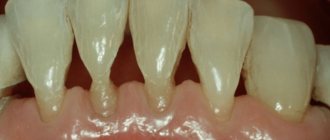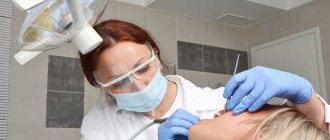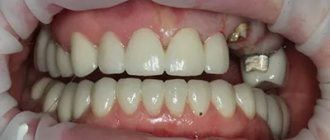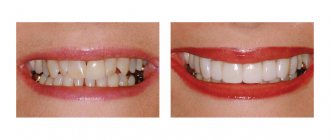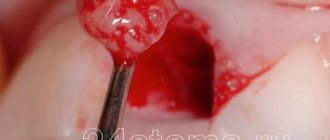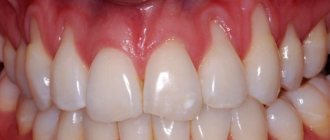How does a tooth rot?
Recognizing that dental tissue is susceptible to rotting is not so difficult. There are a number of pronounced symptoms that indicate this:
- A bad odor appears from the mouth.
- The color of the tooth does not change for the better; it begins to darken.
- Holes appear on the tooth. When food, cold or hot liquids get into them, acute, sometimes unbearable pain is observed.
- In the most advanced cases, loosening of the unit is observed.
If you experience at least one of the above signs, you need to urgently go to the dentist, otherwise you may lose a tooth. Remember that having a rotten tooth is not only an aesthetic drawback. This can lead to other health problems.
Wisdom tooth caries - treat or remove?
It is important to remember that the carious process cannot be left to chance even at the initial stage: the infection spreads quickly, and even healthy organs of the oral cavity can soon be affected. It's time to answer the question that torments many: if wisdom tooth caries is detected, what to do - therapy or removal?
Removal of a wisdom tooth with caries is indicated
- A wisdom tooth is a rudiment that is practically not used in the chewing process, and there is little benefit from it.
- Eights are located far away, access to them is limited, which makes it very difficult to provide quality treatment. This increases the likelihood of re-infection.
- The therapy is tiring for the patient because he has to sit with his mouth wide open throughout the entire procedure. This is especially true for the treatment of caries of the upper wisdom tooth.
As a rule, removal is indicated in cases where the tooth is dystopic and/or impacted, constantly injures the cheeks and tongue, and causes inflammatory processes due to difficult eruption. Whether to remove a wisdom tooth with caries, if it grows normally and does not cause any problems, should be decided individually together with a specialist.
Why is this happening?
The main reason for this problem is poor hygiene, lack of timely dental treatment and neglect of preventive dental examinations. In 90% of cases, it is these factors that cause tooth decay. There are also indirect reasons that can affect this process:
- Having bad habits, especially smoking.
- Hereditary predisposition.
- Bad ecology.
- Poor nutrition.
- Concomitant diseases of the oral cavity.
- Poor quality drinking water.
Deep caries of wisdom tooth
If the development of the carious process is not stopped in time, the infection will gradually penetrate deeper and eventually reach the pulp. Inflammation in the pulp tissue is called pulpitis and is accompanied by aching pain that is difficult to ignore. It is not easy to treat deep caries of wisdom teeth, since it is necessary to fill the root canals, and the roots of figure eights are usually curved. Untreated pulpitis can develop into more serious diseases - wisdom tooth cyst or periodontitis, which are much more difficult to combat.
What could be the consequences?
Complications and consequences can be disappointing. Losing a tooth is not the worst thing that a rotten tooth can lead to. An abundant accumulation of pathogenic microorganisms often provokes problems with the body and disrupts the functioning of internal organs. Let's consider a number of the most common manifestations:
- Blood poisoning.
- Inflammation of the meninges.
- Constant headaches.
- Sleep disturbance.
- Problems with the gastrointestinal tract.
- Lack or significant decrease in appetite.
- Damage to adjacent teeth.
Reasons for the formation of pus in the gums
There are several reasons for the formation of pus:
- The inflammatory process causes a disease such as periodontal disease (gingivitis).
- Periodontal disease.
- Mechanical damage to the gums.
- Chemical or thermal burn.
- Unprofessional removal of tartar, which affected the gums.
- Extensive caries causes pulpitis.
- Failure to comply with hygiene standards when performing dental procedures.
- Unsanitary oral cavity.
- Types 1 and 2 diabetes mellitus.
- Summing up the causes of purulent inflammation of the gums, we can highlight the main factor that causes this disease – the vital activity of pathogenic microorganisms.
So, after contacting the doctor, the following algorithm will follow:
- X-rays must be taken to determine the condition of the tooth root.
- The doctor examines the coronal part of the unit and assesses the situation.
- Construction of a treatment plan. The patient should be explained in detail about the clinical picture and methods of its treatment.
- Be sure to carry out comprehensive hygienic treatment of the oral cavity in order to thoroughly remove plaque and tartar.
- If the root is in normal condition and has no deviations, the canals are cleaned, the tooth is polished and filled. In some cases, depulpation, that is, removal of the nerve, may be required. This procedure is necessary if pulpitis is observed against the background of advanced caries.
- If the rotting process is observed at the root, then the only option is to remove the damaged unit and further prosthetics.
Treatment of wisdom tooth caries
Despite the irrationality of preserving the eight tooth, sometimes the doctor recommends abandoning extreme measures and prescribes treatment for the eighth tooth.
Indications for removal of a wisdom tooth with caries
- Caries is at an early stage: the tooth can be saved, and treatment will not be difficult or expensive.
- The figure eight is involved in prosthetics - for example, it is a support for a bridge or clasp prosthesis.
- The tooth erupts normally, without deviations.
- There is an antagonist that will ensure uniform distribution of the chewing load.
- Removing a wisdom tooth with caries is contraindicated due to pregnancy or other reasons, but it is necessary to stop the spread of infection.
Therapy proceeds as follows:
- the affected tissue is removed with a drill;
- the resulting cavity is disinfected with antiseptic agents, an insulating gasket is placed on the bottom;
- the cavity is filled layer by layer with a composite material, which hardens under the influence of a photopolymer lamp;
- The shape of the tooth is adjusted using a drill so that it looks natural and ensures complete closure with the antagonist tooth.
So if you are wondering whether wisdom teeth cure tooth decay, then the answer is yes. However, it is important to consult a specialist in time and not to advance the disease.
How to prevent trouble
It is much easier to prevent this situation than to solve it. Preventive measures are extremely simple. Just follow a few important tips:
- Make it a rule to go to the dentist every six months for preventive examinations.
- At least once a year you should get rid of tartar and accumulated plaque (this is done in the dentist’s office).
- Hygienic measures must be carried out efficiently and regularly (at least twice a day).
- Nutrition should be complete and varied so that the body does not experience a deficiency of beneficial microelements.
- Try to drink only filtered water.
- Stop smoking as soon as possible.
- Carry out dental treatment in a timely manner.
Indications for preservation
Healthy wisdom teeth do not have a negative impact on the chewing process, so it is not necessary to remove them. You can save third molars in the following cases:
- if they grow evenly;
- if there is no negative effect on the bite;
- do not worry about inflammatory processes in the gum area.
A straight third molar may be beneficial if the patient requires dentures in the future. If the sixth and seventh teeth are removed, the number eight will become a support for the bridge.
Is it expensive to remove a tooth root?
The cost of treatment depends on the location of the clinic and its status. Also a decisive factor is the qualifications and experience of the doctor. As a rule, the price includes:
- diagnostic measures at the preparatory stage;
- consultations with a dentist, anesthesiologist and other specialists;
- painkillers;
- the cost of the operation itself;
- materials used, etc.
Growth period of eights
The average growth period for wisdom teeth is 18-25 years. But they may not erupt at all, and even their rudiments will not be formed inside the bone tissue. In some situations, they can form completely, but remain inside the bone. According to research, approximately 70-80% of the world's population still grows the outermost teeth.
Growing pains
Only some lucky people have wisdom teeth that grow completely, straight, and do not cause any trouble during eruption. Among the main problems that accompany their growth are the following:
- Impacted or semi-impacted teeth, which have formed completely inside the bone tissue, but have not erupted (or partially appeared). They can be vertical, horizontal, or even with their roots up. When positioned laterally, such teeth very often exert increased pressure on neighboring ones, which leads to acute pain,
- A gingival hood forms above the tooth: this is a small area of the mucous membrane that forms during the slow eruption of the tooth. The difficulty is that bacteria and food debris often accumulate underneath it, which are difficult to remove due to the fact that the tooth is very far away - it’s practically impossible to get to it. This causes acute inflammation, which often develops into purulent,
- dystopia or positional imbalance: eights do not have milk precursors, in addition, they grow at a time when the jaw bone has ceased to develop and form. Therefore, they often grow crookedly and do not stand in place. At the same time, they can overlap other crowns, overlap with neighbors, cause injury to the mucous membrane, which will complicate hygiene and provoke inflammatory processes,
- growth immediately with caries: they are very difficult to clean because they are located far away. Patients experience particular difficulties when the mucous membrane is inflamed, since cleaning in such situations is accompanied by acute pain.
In general, growth disturbance leads to a change in the normal functioning of the entire dental system. Soreness occurs, the patient often complains of pain when opening the mouth and moving the lower jaw. Due to pressure on neighboring teeth, they become displaced and cause malocclusion. A fairly common consequence is crowding of the incisors, which occurs precisely as a consequence of impaired growth of the figure eights.
How painful is the procedure?
First of all, most patients are interested in whether it hurts to pull out the root of a tooth and pull out fragments from the alveoli. Modern dentistry uses high-quality anesthesia, under the influence of which the patient feels comfortable and calm during extraction. Drugs are selected for any pain threshold on an individual basis. As a rule, the effect of medicinal compositions persists not only during the period of surgical procedures, but also for several hours after them. Sometimes general anesthesia is required.
The choice of pain relief method depends mainly on the following factors:
- patient's age;
- health conditions;
- complexity of the planned operation.
How long the intervention will last depends on the clinical picture, the condition of the root part, the tooth as a whole and the characteristics of the body. The localization of the unit also plays a vital role. An experienced doctor can handle it in half an hour. However, in difficult cases when it is necessary to get rid of the “eight”, the process can take up to 1.5 hours or more.
Treatment of pathologies with the growth of eights
When a wisdom tooth grows, you should definitely consult a doctor, especially if there is pain or acute inflammation of the mucous membrane over its chewing surface. Consultation with a specialist is also required if pain of unknown etiology occurs - pressing, spreading throughout the lower jaw, appearing when chewing and opening the mouth. In such a situation, you need to take a panoramic photo to establish the exact cause of this condition - it is quite possible that the tooth is located inside the jawbone and is not externally noticeable.
If growth is accompanied by swelling and redness of the mucous membrane, gums moving away from the crown, and acute pain, maintenance therapy is necessary. It is extremely important for the patient himself to carry out the maximum possible oral hygiene - brush the growing wisdom tooth in the morning and evening, use an irrigator after each meal. It is this product that will most effectively remove food debris and bacteria, stopping inflammation.
In case of a serious inflammatory process, plastic surgery may be required to excise the hood - under local anesthesia, part of the gum is cut off, and the space is cleared of deposits. At the same time, drug therapy is prescribed, which will stop the inflammatory process and restore the condition of the tissues.
At the Smile-at-Once clinic, the issue of removing the 8th tooth is resolved strictly individually. We make sure to take a panoramic photo, which allows us to assess the position and degree of impact on the entire dentition. If there is an opportunity to save a tooth and treat it, the clinic’s doctors will definitely take advantage of it.
Indications for removal
It is recommended to remove a wisdom tooth in the following cases:
- if the molar does not erupt completely;
- the tooth grows at an angle, resting on the cheek or tongue;
- caries and crown destruction;
- lack of sufficient space for teething;
- threat of displacement of the dentition due to the inclination of the figure eight;
- trigeminal nerve entrapment;
- obstruction of the canals.
It is recommended to remove a wisdom tooth in case of recurrent suppuration of the mucous membrane.
